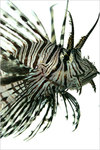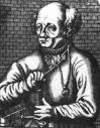Ouch.
 Venomous fish have been tricking us for years with their cute spines and big fangs.
Venomous fish have been tricking us for years with their cute spines and big fangs.
Fuzzy dwarf lionfish would be a great band name. Don’t you think? (That’s a firefish over there, not an FDL.)
 Venomous fish have been tricking us for years with their cute spines and big fangs.
Venomous fish have been tricking us for years with their cute spines and big fangs.
Fuzzy dwarf lionfish would be a great band name. Don’t you think? (That’s a firefish over there, not an FDL.)
DALIAN, China — Tucked away in the back of this coastal city’s export-oriented manufacturing zone is a place that can only be described as a modern mummification factory.
Inside a series of unmarked buildings, hundreds of Chinese workers, some seated in assembly line formations, are cleaning, cutting, dissecting, preserving and re-engineering human corpses, preparing them for the international museum exhibition market.
“Pull the cover off; pull it off,” one Chinese manager says as a team of workers begin to lift a blanket from the head of a cadaver stored in a stainless steel container filled with formalin, a chemical preservative. “Let’s see the face; show the face.”
The mastermind behind this operation is Gunther von Hagens, a 61-year-old German scientist whose show, “Body Worlds,” has attracted 20 million people worldwide over the past decade and has taken in over $200 million by displaying preserved, skinless human corpses with their well-defined muscles and sinewy tissues.
 The NYT covers a recent meeting of science historians about the role of alchemists in advancing various fields, particularly chemistry:
The NYT covers a recent meeting of science historians about the role of alchemists in advancing various fields, particularly chemistry:
But in the revival of scholarship on the field, historians are finding reasons to give at least some alchemists their due. Even though they were secretive and self-deluded and their practices closer to magic than modern scientific methods, historians say, alchemists contributed to the emergence of modern chemistry as a science and an agent of commerce.
“Experimentalism was one of alchemy’s hallmarks,” said Lawrence M. Principe, a historian of science at Johns Hopkins University and a trained chemist. “You have to get your hands dirty, and in this way alchemists forged some early ideas about matter.”
I completely forgot to point to this bizarre story I happened across in the Blood-Horse the other day when I was looking for some Barbaro news. The headline says it all, really: "Cloned Mules to Square Off in California Fair Race". Now, I didn’t know there even was competitive mule racing, let alone with cloned mules. Actually, the headline doesn’t even come close on this one, since it neglects to get across that these mules are cloned from the same genetic material, that of retired world champion Taz. Um, yeah.
But the best part is the article’s ominousish closing:
Jacklin said he has had "quite a few confidential inquiries" from Thoroughbred horsemen interested in the cloning process. "There has been a lot of interest," he said. "I predict we’ll see significant changes in the next few years as organizations begin to address clones. But wouldn’t it be great to see a cloned Cigar race a cloned Funny Cide or another John Henry? I believe it will happen in the future."
Fascinating new data from the Human Genome Project:
According to the new theory, chimps and humans shared a common apelike ancestor much more recently than was thought. Furthermore, when the two emerging species split from each other, it was not a clean break. Some members of the two groups seem to have interbred about 1.2 million years after they first diverged — before going their separate ways for good.
If this theory proves correct, it will mean modern people are descended from something akin to chimp-human hybrids. That is a new idea, and it challenges the prevailing view that hybrids tend to die out.
It also strongly suggests that some of the oldest bones of "proto-humans" — including the 7 million-year-old Toumai skull unearthed in Chad in 2001 — may have belonged to a line of non-hybrids that died out, and were not human ancestors at all.
Monkey See, Monkey You Read More »
From Bruce Sterling’s State of the World 2006:
Adam Greenfield is trying to speak and think very clearly, and to avoid internecine definitional struggles. As a literary guy, though, I think these definitional struggles are a positive force for good. It’s a sign of creative health to be bogged down in internecine definitional struggles. It means we have escaped a previous definitional box. For a technologist, the bog is a rather bad place, because it makes it harder to sell the product. In literature, the bog of definitional struggle is the most fertile area. That is what literature IS, in some sense: it’s taming reality with words. Literature means that we are trying to use words to figure out what things mean, and how we should feel about that.
I’ll be linking this one again later in a different context, but it’s worth going there and reading the whole thing.
(p.s. If I linksnatched this from you, I’m sorry — it’s been an open tab for days and I can’t remember where I spotted it.)
On Definitional Fisticuffs Read More »
Claire Light’s new blog on maps and taxonomy and things related is completely fabulous. I especially love this entry.
 A so-so piece in the WaPo about the death of Addwaita, a very old turtle:
A so-so piece in the WaPo about the death of Addwaita, a very old turtle:
One of the world’s oldest living creatures died last week in Calcutta.
Addwaita, a tortoise believed to be 250 years old, died at the local zoo. The tortoise arrived there in 1875. Zoo officials, who have yet to definitively prove Addwaita’s age, say he was one of four tortoises that had been brought to India more than a century earlier by British sailors from the Seychelles islands as a gift for Lord Robert Clive of the East India Co. Clive, who kept the turtle in his garden, was instrumental in establishing British colonial rule in India before he returned to England in 1767.
Mostly, what this piece has to recommend it is its continued reliance on the words of Don Marquis’ archy. Everybody loves archy.
archy says goodnight Read More »
![]() Meet the ACM-R5 Amphibious Snake-Like Robot. (Via William Gibson.)
Meet the ACM-R5 Amphibious Snake-Like Robot. (Via William Gibson.)
Also, I join the rest of the world in drooling over Google Mars. And hey, I’m still sweet on Google Moon.
Snake, I Think I Love You. Read More »
 I’m just saying there are rules when things like this happen:
I’m just saying there are rules when things like this happen:
A team of scientists has discovered a lost world of rare plants, giant flowers and bizarre animals — including a new species of honeyeater bird, a tree kangaroo and an egg-laying mammal — on a mist-shrouded mountaintop in a remote province of Indonesia on New Guinea island.
There’s a photo gallery.
Do Not Awaken the Ancient Evil. Read More »